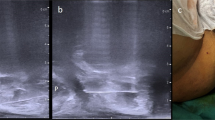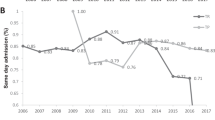Abstract
Background
Transrectal (TR) ultrasound-guided prostate biopsy is one of the most commonly performed urologic procedures worldwide. The major drawback of this approach is the associated risk for infectious complications. Sepsis rates are increasing due to rising antibiotic resistance, representing a global issue. The transperineal (TP) approach for prostate biopsy has recently been adopted at many centres as an alternative to the TR biopsy, and it was shown to be associated with a lower risk for sepsis. The aim of this study was to assess safety and tolerability of TP prostate biopsy performed in local anaesthesia.
Methods
We retrospectively analysed data of patients who had undergone office-based TP prostate biopsy in local anaesthesia, performed by a single surgeon between January 2015 and May 2019. We evaluated the patients’ acceptance of the procedure by a pain score, as well as its safety and diagnostic performance.
Results
Four hundred patients were included. Median age was 66 years [range, 49–86]. Median prostate-specific antigen (PSA) concentration was 6.4 ng/ml [range, 0.3–1400], median PSA density was 0.15 ng/ml2 [range, 0–31.1] and median prostate volume was 40 ml [range, 6–150]. A total of 118 (29.5%) and 105 (26.2%) patients had orally received two and one doses of 500 mg fluoroquinolone, respectively, and 177 (44.3%) patients did not receive any antibiotic prophylaxis. No infectious complications occurred. Median pain score was 2.0 (range, 0–8). Overall cancer detection rate was 64.5% (258/400).
Conclusions
Freehand TP prostate biopsy in local anaesthesia is a safe, effective and well-tolerated outpatient procedure with a high cancer detection rate. The elimination of infectious complications and its high accuracy make this technique a feasible alternative to the TR approach for the urological office. We assume that the single puncture and our trocar-like access sheath introduction technique diminish tissue trauma and bacterial exposition, and thus contribute to these promising results.
This is a preview of subscription content, access via your institution
Access options
Subscribe to this journal
Receive 4 print issues and online access
$259.00 per year
only $64.75 per issue
Buy this article
- Purchase on Springer Link
- Instant access to full article PDF
Prices may be subject to local taxes which are calculated during checkout


Similar content being viewed by others
References
Heidenreich A, Bastian PJ, Bellmunt J, Bolla M, Joniau S, van der Kwast T, et al. EAU guidelines on prostate cancer. Part 1: screening, diagnosis, and local treatment with curative intent-update 2013. Eur Urol. 2014;65:124–37.
Litwin MS, Tan HJ. The diagnosis and treatment of prostate cancer: a review. JAMA. 2017;317:2532–42.
Liu W, Patil D, Howard DH, Moore RH, Wang H, Sanda MG, et al. Adoption of prebiopsy magnetic resonance imaging for men undergoing prostate biopsy in the United States. Urology. 2018;117:57–63.
Loeb S, Carter HB, Berndt SI, Ricker W, Schaeffer EM. Complications after prostate biopsy: data from SEER-Medicare. J Urol. 2011;186:1830–4.
Borghesi M, Ahmed H, Nam R, Schaeffer E, Schiavina R, Taneja S, et al. Complications after systematic, random, and image-guided prostate biopsy. Eur Urol. 2017;71:353–65.
Loeb S, van den Heuvel S, Zhu X, Bangma CH, Schroder FH, Roobol MJ. Infectious complications and hospital admissions after prostate biopsy in a European randomized trial. Eur Urol. 2012;61:1110–4.
Pepdjonovic L, Tan GH, Huang S, Mann S, Frydenberg M, Moon D, et al. Zero hospital admissions for infection after 577 transperineal prostate biopsies using single-dose cephazolin prophylaxis. World J Urol. 2017;35:1199–203.
Symons JL, Huo A, Yuen CL, Haynes AM, Matthews J, Sutherland RL, et al. Outcomes of transperineal template-guided prostate biopsy in 409 patients. BJU Int. 2013;112:585–93.
Altok M, Kim B, Patel BB, Shih YT, Ward JF, McRae SE, et al. Cost and efficacy comparison of five prostate biopsy modalities: a platform for integrating cost into novel-platform comparative research. Prostate Cancer Prostatic Dis. 2018;21:524–32.
Gross MD, Shoag JE, Hu JC. Is in-office transperineal biopsy the future of prostate cancer diagnosis? Curr Opin Urol. 2019;29:25–26.
Zimmerman ME, Meyer AR, Carter HB, Allaf ME, Gorin MA. In-office transperineal prostate biopsy using biplanar ultrasound guidance: a step-by-step guide. Urology. 2019;133:247.
Dimmen M, Vlatkovic L, Hole KH, Nesland JM, Brennhovd B, Axcrona K. Transperineal prostate biopsy detects significant cancer in patients with elevated prostate-specific antigen (PSA) levels and previous negative transrectal biopsies. BJU Int. 2012;110(2 Pt 2):E69–75.
Mabjeesh NJ, Lidawi G, Chen J, German L, Matzkin H. High detection rate of significant prostate tumours in anterior zones using transperineal ultrasound-guided template saturation biopsy. BJU Int. 2012;110:993–7.
Stefanova V, Buckley R, Flax S, Spevack L, Hajek D, Tunis A, et al. Transperineal prostate biopsies using local anesthesia: experience with 1287 patients. Prostate cancer detection rate, complications and patient tolerability. J Urol. 2019;201:1121–6.
Meyer AR, Joice GA, Schwen ZR, Partin AW, Allaf ME, Gorin MA. Initial experience performing in-office ultrasound-guided transperineal prostate biopsy under local anesthesia using the precisionpoint transperineal access system. Urology. 2018;115:8–13.
Thurtle D, Starling L, Leonard K, Stone T, Gnanapragasam VJ. Improving the safety and tolerability of local anaesthetic outpatient transperineal prostate biopsies: a pilot study of the CAMbridge PROstate Biopsy (CAMPROBE) method. J Clin Urol. 2018;11:192–9.
Emiliozzi P, Longhi S, Scarpone P, Pansadoro A, DePaula F, Pansadoro V. The value of a single biopsy with 12 transperineal cores for detecting prostate cancer in patients with elevated prostate specific antigen. J Urol. 2001;166:845–50.
Dindo D, Demartines N, Clavien PA. Classification of surgical complications: a new proposal with evaluation in a cohort of 6336 patients and results of a survey. Ann Surg. 2004;240:205–13.
Xue J, Qin Z, Cai H, Zhang C, Li X, Xu W, et al. Comparison between transrectal and transperineal prostate biopsy for detection of prostate cancer: a meta-analysis and trial sequential analysis. Oncotarget. 2017;8:23322–36.
Carignan A, Roussy JF, Lapointe V, Valiquette L, Sabbagh R, Pepin J. Increasing risk of infectious complications after transrectal ultrasound-guided prostate biopsies: time to reassess antimicrobial prophylaxis? Eur Urol. 2012;62:453–9.
Evans SMTG, Brooks A, Currow D, Davis ID, Delprado W, Frizelle F. et al. Prostate cancer outcomes registry-Australia and New Zealand Report 2018. Reporting on data 2015–2016. Melbourne, VIC: Monash University & The Movember Foundation; 2018.
National Prostate Cancer Audit. Results of the NPCA prospective audit in England and Wales for men diagnosed from 1 April 2016 to 31 March 2017. National Prostate Cancer Audit. London: The Royal College of Surgeons of England.
Grummet J, Pepdjonovic L, Huang S, Anderson E, Hadaschik B. Transperineal vs. transrectal biopsy in MRI targeting. Transl Androl Urol. 2017;6:368–75.
Acknowledgements
The authors want to thank Dr Selina Ackermann from the University Hospital Basel for editorial assistance.
Author information
Authors and Affiliations
Corresponding author
Ethics declarations
Conflict of interest
The authors declare that they have no conflict of interest.
Additional information
Publisher’s note Springer Nature remains neutral with regard to jurisdictional claims in published maps and institutional affiliations.
Rights and permissions
About this article
Cite this article
Wetterauer, C., Shahin, O., Federer-Gsponer, J.R. et al. Feasibility of freehand MRI/US cognitive fusion transperineal biopsy of the prostate in local anaesthesia as in-office procedure—experience with 400 patients. Prostate Cancer Prostatic Dis 23, 429–434 (2020). https://doi.org/10.1038/s41391-019-0201-y
Received:
Revised:
Accepted:
Published:
Issue Date:
DOI: https://doi.org/10.1038/s41391-019-0201-y
This article is cited by
-
Transrectal prostate biopsy: easy, effective and safe
Prostate Cancer and Prostatic Diseases (2024)
-
Transperineal ultrasound-guided prostate biopsy: what the radiologist needs to know
Insights into Imaging (2022)
-
Comprehensive analysis of complications after transperineal prostate biopsy without antibiotic prophylaxis: results of a multicenter trial with 30 days’ follow-up
Prostate Cancer and Prostatic Diseases (2022)
-
Rationale and protocol for randomized study of transrectal and transperineal prostate biopsy efficacy and complications (ProBE-PC study)
Prostate Cancer and Prostatic Diseases (2021)
-
Diagnostic accuracy and clinical implications of robotic assisted MRI-US fusion guided target saturation biopsy of the prostate
Scientific Reports (2021)



